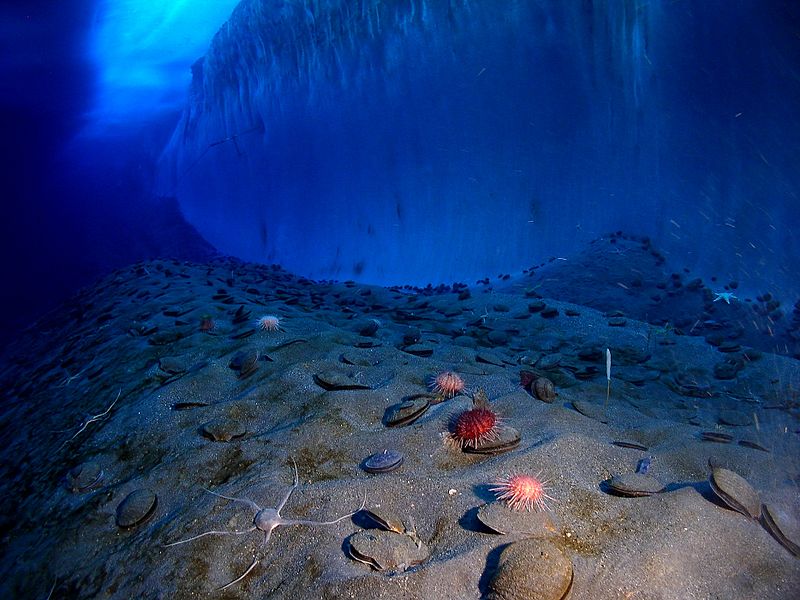A recent article on undersea mining in The Atlantic brought back a detailed childhood memory. When I was in fifth grade, my class put on a sort of mini science fair and performance art program for parents. My project focused on the prospect of mining the oceans. I drew a large mural-like color illustration showing a submarine stationed just above the seabed where it hoovered up minerals with large hoses.
The submarine had wide pipes running from it to the surface where a ship received the nodules of ore gathered by the hoses. During my presentation the classroom was dark, and my mural was illuminated using three small articulating lamps turned on and off by a classmate as I went through the distinct phases of the mining operations in a room meant to mimic the dark and foreboding deep.
It turns out these many years later that my cursory research into ocean mining as a fifth-grader yielded a roughly accurate portrayal of what is about to happen in the oceans starting early in the coming decade. The world’s nations may conclude a treaty governing undersea mining through the auspices of the United Nations as early as next year. Once that is concluded, large scale mining of ocean bottoms is expected to begin.
One method—already in use in coastal waters controlled by individual countries—will be to suck up nodules of ore lying on the seabed with huge vacuums and filter out the sediment that comes with it. This method will move quickly to the deep ocean once the treaty is approved resulting in huge, dense clouds of particles suspended underwater for possibly hundreds of miles from underwater mining sites. Scientists are worried that both the vacuuming and the plumes will destroy entire ecosystems about which we know little.
I am reminded of the hydraulic mining employed in California in the late 19th century to recover gold from the mountains there. What looks like natural erosion today in those mountains is quite often the result of high-pressure washing of mountainsides with water to unearth specks of gold hidden in the soil.
Geologists estimate that this type of mining sent 13 billion cubic yards of the Sierra Nevadashurtling down the mountains and into California’s rivers. The river bottoms filled, rose and dumped their debris on adjacent land covering thousand of acres of farmland with the detritus from mining. When the water reached the ocean underneath San Francisco’s Golden Gate bridge, it was still brown with silt.
Deep ocean mining will probably not affect shorelines because the mining will take place too far from land. But the affects are likely to be profound nonetheless. It turns that:
About a third of the carbon dioxide generated on land is absorbed by underwater organisms, including one species that was just discovered in the CCZ in 2018. [The Clarion-Clipperton Zone, located between Hawaii and Mexico, is 1.7 million square miles of prime underwater real estate for mining that is also teaming with life.] The researchers who found that bacterium have no idea how it removes carbon from the environment, but their findings show that it may account for up to 10 percent of the volume that is sequestered by oceans every year.
I have asked in a previous piece: “Which species are we sure we can survive without?” This little bacterium may be one of them. But, as it turns out, there are an untold number of species we know nothing about because no one has had the resources or equipment to go deep into the ocean to make a thorough-going catalog of living organisms there. Even so, we stand of the edge of eliminating many of them without even understanding whether we might need them to survive.
All of this will ironically be in service to the so-called “green economy.” Minerals found on ocean seabeds—copper, cobalt, and manganese—are crucial to the move away from fossil fuels toward electricity as fuel for the world’s transportation fleet. Will we end up devastating ocean organisms that absorb more carbon dioxide than we’ll save by moving toward electrified transportation? In our blindness we can’t see that our solutions lead to more problems, some of which merely compound our woes. The plumes resulting from undersea mining will contain in some cases mercury and lead liberated from the seabed that will poison the surrounding ocean and creatures large and small living there.
When I did my fifth-grade presentation, I wasn’t thinking of consequences, only riches. I passed around samples of metals I had acquired from a high-school chemistry teacher who took an interest in my project. Small, irregular globules of manganese, copper, and iron—metals which the mining operations might capture in the form of polymetallic chunks—were circulated among the parents and students.
Someday somebody’s going to get rich mining these minerals, I thought at the time. That someday seems to be arriving.
Photo: “Image of an ice wall and the ocean floor at Explorer’s Cover, New Harbor, McMurdo Sound. .. Main visible species :
the antarctic scallop (Adamussium colbecki)
the common antarctic sea urchin (Sterechinus neumayeri)
a stalk-like bush sponge (Homaxinella balfourensis)
a brittlestar (Ophionotus victoriae) seaspiders (Colossendeis sp.)’
Via Wikimedia commons https://commons.wikimedia.org/wiki/File:Underwater_mcmurdo_sound.jpg






